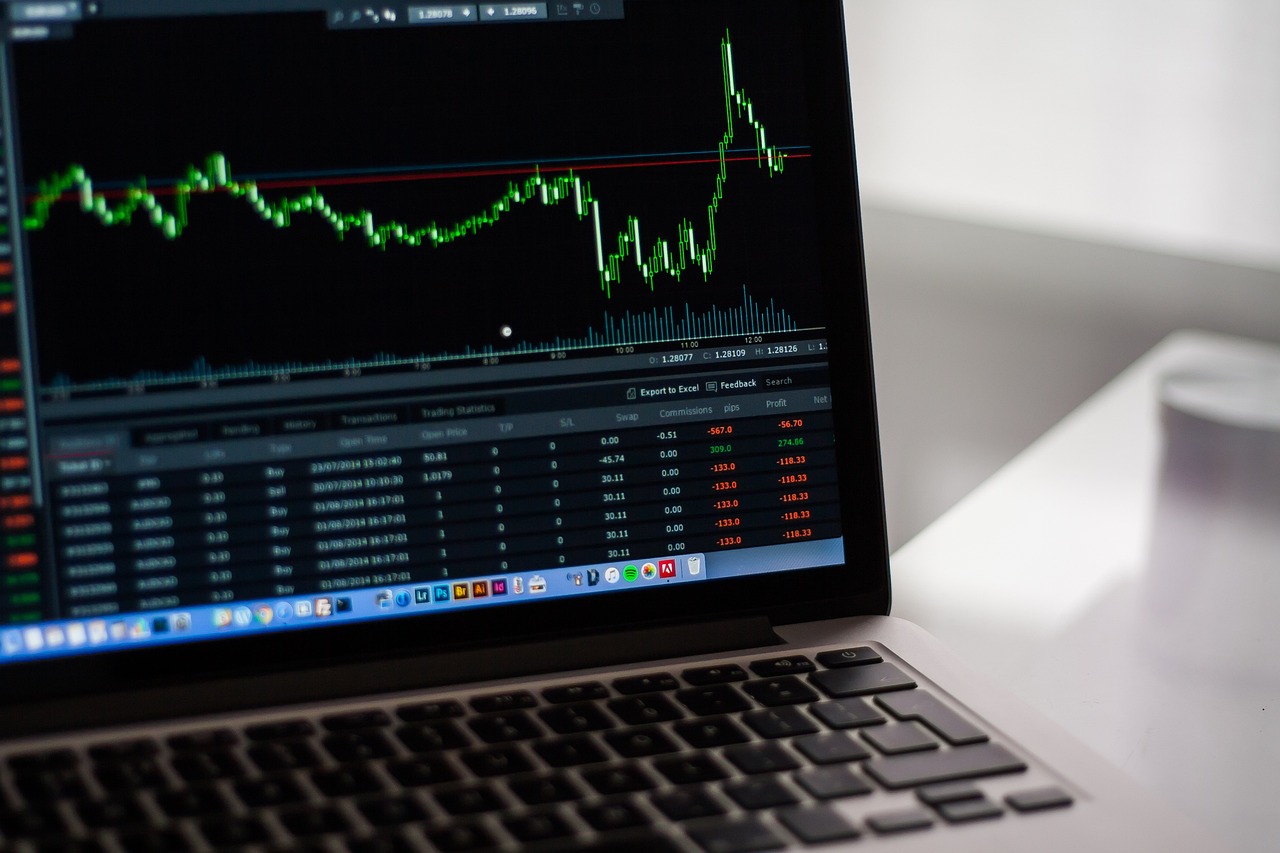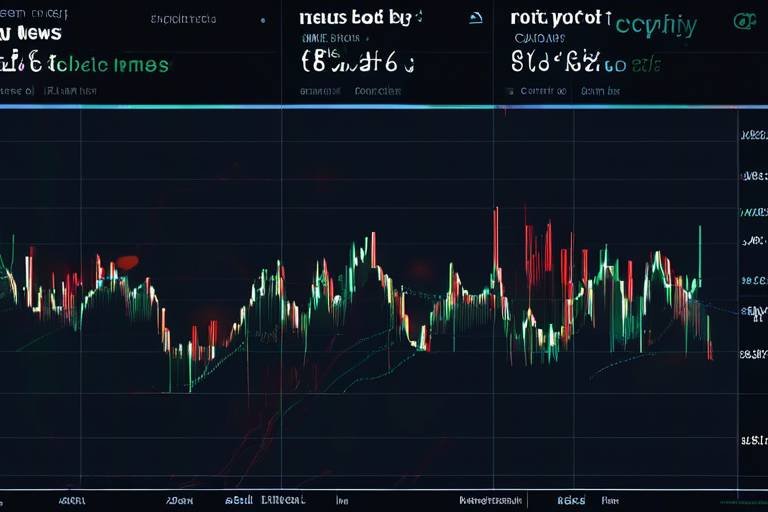Understanding Market Trends in the Context of Global Finance
In the ever-evolving world of finance, understanding market trends is crucial for investors, policymakers, and anyone interested in the economic landscape. Market trends are like the weather; they can change rapidly, and being prepared for these shifts can mean the difference between profit and loss. So, what exactly are market trends? They are the general direction in which a market is moving, influenced by various factors such as economic indicators, globalization, technology, and political stability. In this article, we will explore the dynamics of these trends, their impact on global finance, and the essential factors that influence them.
To grasp the significance of market trends, it's essential to recognize that they don't exist in a vacuum. They are the result of a complex interplay of economic, social, and political factors. Think of it as a giant puzzle, where each piece—be it economic indicators, globalization, or technological advancements—contributes to the bigger picture of the global financial landscape. Understanding how these pieces fit together can provide valuable insights into the future of financial markets.
For instance, consider how economic indicators, such as GDP growth rates and unemployment figures, serve as vital signs of economic health. Investors closely monitor these indicators because they can signal potential market movements. A robust economy typically leads to increased consumer spending, which can drive stock prices up. Conversely, rising unemployment rates may indicate economic troubles ahead, prompting investors to pull back. This intricate dance of numbers and trends is what makes the financial world both thrilling and daunting.
Moreover, the impact of globalization cannot be overstated. The world is more interconnected than ever, and events in one part of the globe can ripple through financial markets worldwide. For example, a political crisis in a country can lead to fluctuations in commodity prices, affecting economies thousands of miles away. Investors must navigate this complex web of interactions, making it essential to stay informed about global events and trends.
As we delve deeper into the various aspects that shape market trends, we'll uncover how cross-border investments, emerging markets, and technological advancements play pivotal roles in influencing investor behavior. For example, emerging markets present unique opportunities, often characterized by rapid growth and high volatility. They can be like a double-edged sword; while they offer the potential for high returns, they also come with significant risks that investors must carefully assess.
In conclusion, understanding market trends is not merely an academic exercise; it's a vital skill for anyone looking to navigate the complex world of global finance. By keeping an eye on economic indicators, the effects of globalization, and technological innovations, investors can better position themselves to make informed decisions. As we continue through this article, we will explore these themes in greater detail, providing you with the tools and insights needed to thrive in the dynamic financial landscape.
- What are market trends? Market trends refer to the general direction in which a market is moving, influenced by various economic, social, and political factors.
- Why are economic indicators important? Economic indicators provide insights into the health of an economy, helping investors make informed decisions based on potential market movements.
- How does globalization affect market trends? Globalization creates interconnected economies, meaning events in one region can influence financial markets worldwide.
- What are emerging markets? Emerging markets are economies that are in the process of rapid growth and industrialization, often presenting unique investment opportunities and risks.
- How do technological advancements influence market trends? Technology, especially fintech innovations, can change trading patterns and investment strategies, impacting market behavior.

The Role of Economic Indicators
Economic indicators are like the pulse of a nation’s economy, giving us vital signs that help us understand its health and direction. They serve as essential tools for investors, policymakers, and analysts, providing insights into various aspects of economic performance. Think of them as the breadcrumbs that lead us through the complex forest of financial data, guiding our decisions and strategies. When we talk about economic indicators, we refer to a range of statistics that reflect the overall economic activity, including Gross Domestic Product (GDP), unemployment rates, inflation rates, and consumer confidence indices.
For instance, when GDP is on the rise, it typically indicates a growing economy, which can lead to increased consumer spending and business investments. Conversely, a dip in GDP might signal economic trouble, causing investors to rethink their strategies. Unemployment rates also play a crucial role; high unemployment can lead to decreased consumer spending, while low unemployment usually correlates with a robust economy. In essence, these indicators not only reflect the current state of the economy but also help predict future trends, making them invaluable for anyone involved in the financial markets.
Moreover, it’s important to recognize that economic indicators do not operate in a vacuum. They are interconnected and can influence one another. For example, rising inflation might lead to higher interest rates, which in turn can affect consumer spending and investment. Understanding these relationships is key to making informed decisions in the global financial landscape.
To illustrate the significance of these indicators, let’s look at a simplified table of some key economic indicators and what they typically signify:
| Economic Indicator | What It Indicates |
|---|---|
| Gross Domestic Product (GDP) | Overall economic health and growth |
| Unemployment Rate | Labor market strength and economic activity |
| Inflation Rate | Purchasing power and cost of living |
| Consumer Confidence Index | Consumer spending and economic outlook |
In addition, the timing of these indicators can greatly affect market reactions. For example, if the unemployment rate drops unexpectedly, it could lead to a surge in stock prices as investors feel more confident about consumer spending. On the flip side, if inflation rates rise faster than anticipated, it might trigger a sell-off in the markets due to fears of tightening monetary policy. Thus, staying updated with these indicators is crucial for anyone looking to navigate the financial waters successfully.
In conclusion, economic indicators are not just numbers; they are the language of the economy, telling us stories about growth, stability, and potential risks. By paying attention to these indicators, we can better understand market trends and make more informed investment decisions. Whether you're a seasoned investor or a newcomer trying to find your footing, keeping an eye on these economic signals can help you stay ahead of the curve in the ever-evolving financial landscape.
- What are economic indicators? Economic indicators are statistics that provide information about the economic performance of a country, such as GDP, unemployment rates, and inflation rates.
- Why are economic indicators important? They help investors and policymakers make informed decisions by reflecting the health of the economy and predicting future trends.
- How do economic indicators affect investment decisions? Changes in economic indicators can influence market sentiment, leading to shifts in investment strategies and asset prices.
- Can economic indicators be misleading? Yes, sometimes indicators can be subject to revisions or may not capture the full picture of economic health, leading to misinterpretations.

Globalization and Its Impact
Globalization has dramatically reshaped the financial landscape over the past few decades, creating a web of interconnected economies that influences market trends on a global scale. With the advent of technology and communication advancements, borders have become less significant, allowing capital, goods, and services to flow freely across nations. This transformation has led to a more integrated world economy where events in one region can have ripple effects across the globe. But what does this mean for investors and policymakers? Let’s dive deeper into the intricacies of globalization and its profound impact on market trends.
One of the most significant effects of globalization is the rise of cross-border investments. Investors are no longer limited to their domestic markets; they can now explore opportunities worldwide. This accessibility creates a diverse range of investment options but also introduces new risks. For instance, a political upheaval in one country can lead to a sudden withdrawal of foreign investments, causing market instability not only locally but also affecting global investor sentiment. This interconnectedness means that understanding foreign markets is crucial for making informed investment decisions.
Furthermore, globalization has given rise to emerging markets, which present unique opportunities for growth. Countries such as India, Brazil, and China have become attractive destinations for investors seeking higher returns. These markets often experience rapid economic growth, driven by a burgeoning middle class and increasing consumer demand. However, they are also characterized by volatility and regulatory challenges that investors must navigate carefully. The potential for high returns comes with a corresponding level of risk that can’t be ignored.
On the flip side, developed markets like the United States and the Eurozone continue to play a pivotal role in shaping global finance. They provide stability and a sense of security for investors, but they are not immune to the influences of globalization. Trends in these markets can set the tone for global financial conditions. For instance, changes in interest rates or economic policies in the U.S. can lead to significant shifts in capital flows, affecting emerging markets and creating a domino effect across the globe.
To illustrate the impact of globalization on market trends, consider the following table that highlights key factors and their influence:
| Factor | Impact on Market Trends |
|---|---|
| Cross-Border Investments | Increased capital flow, diversification of portfolios, exposure to foreign risks |
| Emerging Markets | Higher growth potential, increased volatility, regulatory challenges |
| Developed Markets | Market stability, influence on global capital flows, economic policy impacts |
As globalization continues to evolve, its impact on market trends will only grow more complex. Investors must stay vigilant, adapting their strategies to navigate this ever-changing landscape. The interplay between local and global factors will dictate market movements, making it essential for both investors and policymakers to understand these dynamics fully. So, how can one prepare for this globalized financial environment? The answer lies in continuous learning, staying informed about international developments, and being ready to pivot strategies as needed.
- What is globalization? Globalization refers to the process by which businesses or other organizations develop international influence or start operating on an international scale.
- How does globalization affect investments? Globalization allows investors to access a wider array of investment opportunities but also introduces new risks associated with foreign markets.
- What are emerging markets? Emerging markets are countries that are in the process of rapid growth and industrialization, often characterized by increased economic activity and investment potential.
- Why are developed markets important? Developed markets provide stability and are often seen as safer investments, influencing global financial conditions and trends.

Cross-Border Investments
In today's interconnected world, have become a central theme in the global financial narrative. These investments, which involve capital flowing from one country to another, are not just numbers on a balance sheet; they represent opportunities, risks, and the intricate dance of global economics. Imagine a vast web where each thread is a financial transaction connecting diverse markets, cultures, and economies. This web is constantly evolving, influenced by various factors such as economic conditions, political stability, and technological advancements.
One of the most fascinating aspects of cross-border investments is how they can drive growth in emerging markets. For example, when foreign investors pour money into a developing country, they are not merely seeking profits; they are also providing vital resources that can lead to job creation and infrastructure development. This influx of capital can transform local economies, often acting as a catalyst for innovation and progress. However, it’s essential to understand that while these investments can bring substantial benefits, they also come with their fair share of challenges.
Consider the potential risks associated with cross-border investments. Investors must navigate a complex landscape of regulations, currency fluctuations, and geopolitical tensions. For instance, a sudden political upheaval in a host country can jeopardize investments, leading to significant financial losses. Furthermore, the foreign exchange market can be notoriously volatile, and fluctuations in currency values can impact the returns on investments. Therefore, investors need to conduct thorough due diligence and remain vigilant about the changing dynamics of the markets they are engaging with.
To illustrate the impact of cross-border investments, let’s take a look at a few key statistics:
| Year | Global FDI Inflows (in billion USD) | Top Regions for FDI |
|---|---|---|
| 2020 | 1,540 | Asia, Europe, North America |
| 2021 | 1,650 | Asia, Europe, North America |
| 2022 | 1,700 | Asia, Europe, North America |
As shown in the table, Foreign Direct Investment (FDI) inflows have been steadily increasing, highlighting the growing interest in cross-border investments. Investors are continually seeking opportunities in various regions, particularly in Asia, which has emerged as a hotspot for FDI due to its dynamic markets and robust economic growth.
In conclusion, cross-border investments are not merely a financial strategy; they represent a global phenomenon that shapes the economic landscape. As investors navigate this complex web of opportunities and risks, they must remain informed and adaptable. The future of cross-border investments will undoubtedly be influenced by technological advancements, changing political climates, and evolving market dynamics. Understanding these factors will be crucial for anyone looking to make their mark in the world of global finance.
- What are cross-border investments? Cross-border investments refer to the movement of capital across national borders, involving investments in foreign assets or businesses.
- Why are cross-border investments important? They facilitate economic growth, promote job creation, and foster innovation in host countries.
- What risks are associated with cross-border investments? Risks include political instability, currency fluctuations, and regulatory challenges.
- How can investors mitigate risks in cross-border investments? Investors can conduct thorough due diligence, diversify their portfolios, and stay informed about global market trends.

Emerging Markets
Emerging markets are often seen as the wild west of the financial world. They are characterized by rapid growth, evolving economic structures, and a plethora of opportunities and risks that can leave investors both excited and apprehensive. These markets, which include countries like Brazil, India, and Nigeria, are in a state of flux, constantly adapting to global economic shifts, technological advancements, and sociopolitical changes. But what makes them so alluring? Well, it’s all about the potential for high returns. Investors are drawn to emerging markets because they often experience growth rates that far exceed those of developed countries.
However, investing in these markets is not without its challenges. The volatility inherent in emerging markets can lead to significant fluctuations in investment values. Factors such as political instability, currency fluctuations, and regulatory changes can dramatically impact market performance. For instance, consider the recent surge in technology adoption in countries like India, which has created a booming tech startup scene. This situation presents a golden opportunity for investors looking to capitalize on the next big thing. Yet, it also comes with risks, as the regulatory environment can change overnight, leaving investors scrambling.
To better understand the dynamics at play, let’s break down some key characteristics of emerging markets:
- Rapid Economic Growth: Emerging markets often experience higher GDP growth rates compared to developed nations, driven by urbanization and industrialization.
- Young Population: Many emerging markets have a youthful demographic, which can lead to a vibrant labor force and increased consumer spending.
- Increased Foreign Investment: As these markets stabilize, they attract more foreign direct investment (FDI), which can spur further economic growth.
- Technological Leapfrogging: Emerging economies are often quick to adopt new technologies, bypassing older systems and creating innovative solutions.
In terms of investment strategies, it’s crucial to conduct thorough research and understand the local context. Investors should be aware of the socio-economic factors that influence market trends, such as income inequality, education levels, and infrastructure development. For instance, a country with a strong focus on improving its education system may see a more skilled workforce emerge, leading to increased productivity and economic growth.
Moreover, it's essential to keep an eye on the political landscape. Political stability can significantly affect investor confidence and market performance. Countries that are undergoing major reforms or facing political turmoil may present both risks and opportunities. For example, a government that is committed to economic liberalization may create a more favorable environment for foreign investors, while political unrest can lead to market sell-offs and increased volatility.
In conclusion, while emerging markets offer enticing opportunities for growth and profit, they require a careful and informed approach. Investors must balance the potential for high returns with the risks of volatility and uncertainty. By staying informed about the economic indicators, political climate, and technological advancements in these regions, investors can navigate the complexities of emerging markets and potentially reap substantial rewards.
Q: What are emerging markets?
A: Emerging markets are economies that are in the process of rapid growth and industrialization. They typically have lower income levels compared to developed countries but offer greater potential for investment returns.
Q: Why should I invest in emerging markets?
A: Investing in emerging markets can provide high growth potential, diversification, and exposure to new consumer markets, but it also comes with higher risks, including political instability and currency fluctuations.
Q: How do I assess the risks of investing in emerging markets?
A: Investors should analyze economic indicators, political stability, market trends, and local regulations to assess risks. It's also wise to stay informed about global economic conditions that may impact these markets.

Developed Markets
When we talk about , we’re diving into a realm that boasts stability, liquidity, and a wealth of investment opportunities. These markets, which include countries like the United States, Canada, Japan, and most of Western Europe, are characterized by their mature economies, advanced technological infrastructure, and established financial systems. The significance of developed markets in the global financial landscape cannot be overstated; they often set the tone for market trends worldwide.
One of the key features of developed markets is their high level of transparency. Investors can access a wealth of information about companies, economic indicators, and regulatory environments, which helps in making informed decisions. This transparency fosters a sense of confidence among investors, which is crucial for market stability. For instance, the U.S. stock market is known for its rigorous reporting standards, allowing investors to gauge the financial health of companies effectively.
Moreover, developed markets tend to have a diverse range of investment options. From equities and bonds to real estate and commodities, investors have a plethora of choices. This diversity not only enhances the potential for returns but also allows for better risk management. For example, during times of economic uncertainty, investors might pivot towards safer assets like government bonds or high-quality corporate bonds, which are more prevalent in developed markets.
However, it’s essential to understand that developed markets are not without their challenges. For instance, they can experience market saturation, where growth opportunities become limited due to the already established nature of the economy. This is where innovation and adaptation come into play. Companies in developed markets must continuously evolve, tapping into new technologies or exploring global markets to sustain growth. The rise of fintech companies is a prime example of how traditional financial institutions are transforming to meet the demands of a tech-savvy consumer base.
Furthermore, developed markets are often influenced by global economic shifts, making them susceptible to external factors such as trade policies, geopolitical tensions, and even environmental changes. The interconnectedness of these markets means that a financial crisis in one region can ripple across the globe, affecting investor sentiment and market stability. For instance, the 2008 financial crisis highlighted how deeply intertwined developed markets are, as the collapse of the U.S. housing market had far-reaching consequences for economies worldwide.
In summary, while developed markets offer a robust framework for investment, they also require investors to stay informed and agile. Understanding the nuances of these markets, from the regulatory environment to consumer behavior, is crucial for making strategic investment decisions. As we move forward, the adaptability of developed markets will be tested, but their foundational strength will continue to attract investors seeking stability and growth.
- What are developed markets? Developed markets refer to countries with mature economies, characterized by high income levels, advanced infrastructure, and stable political environments.
- Why are developed markets important? They serve as benchmarks for global financial trends and provide a wide range of investment opportunities with lower risk compared to emerging markets.
- What are some examples of developed markets? Examples include the United States, Canada, Japan, Germany, and the United Kingdom.
- How do developed markets impact global finance? Developed markets influence global investment flows, trade policies, and economic stability, often setting the tone for emerging markets.

Technological Advancements
In today's fast-paced world, technology is not just a tool; it's a game-changer that has revolutionized the way we think about markets and investments. The rise of fintech, artificial intelligence, and blockchain technology has transformed the financial landscape, making it essential for investors and policymakers to understand these advancements. Imagine a world where transactions happen in seconds, where data analytics can predict market trends with astounding accuracy, and where barriers to entry in finance are lowered for everyone. Sounds futuristic, right? But this is the reality we are living in today.
One of the most significant impacts of technology on market trends is the emergence of algorithmic trading. This involves using complex algorithms to execute trades at high speeds, often in milliseconds. These algorithms analyze vast amounts of data to identify trading opportunities, enabling investors to capitalize on minute price fluctuations. As a result, the market has become more efficient, but it has also led to increased volatility. The question arises: are we in control of our investments, or are we at the mercy of machines?
Additionally, the advent of blockchain technology is reshaping the financial sector. By providing a decentralized ledger, blockchain enhances transparency and security in transactions. This technology not only facilitates cryptocurrencies but also streamlines processes in traditional finance, such as clearing and settlement. The implications for global finance are profound, as it reduces costs and increases trust among market participants. However, it also raises questions about regulation and the future role of central banks.
Moreover, the rise of robo-advisors has democratized investing, allowing individuals to access sophisticated investment strategies without needing a financial advisor. These platforms use algorithms to create personalized portfolios based on individual risk tolerance and investment goals. As more people engage in investing, we see a shift in market dynamics driven by retail investors. This shift can lead to unexpected trends, as collective behavior begins to influence market movements.
As technology continues to evolve, it's crucial to stay informed about the latest trends. Here’s a brief overview of some key technological advancements affecting market trends:
| Technology | Impact on Markets |
|---|---|
| Algorithmic Trading | Increases market efficiency but contributes to volatility. |
| Blockchain | Enhances transparency and reduces transaction costs. |
| Robo-Advisors | Democratizes investing, impacting retail investor behavior. |
| Artificial Intelligence | Improves data analysis and predictive capabilities. |
In conclusion, technological advancements are reshaping the financial landscape in ways we could have only dreamed of a decade ago. They bring both opportunities and challenges, pushing us to adapt and rethink our strategies. As we navigate this ever-changing environment, one thing is clear: staying ahead of the curve is not just an option; it's a necessity for anyone looking to thrive in the world of finance.
- What is algorithmic trading? Algorithmic trading uses computer algorithms to execute trades based on predefined criteria, allowing for faster and more efficient trading.
- How does blockchain technology impact finance? Blockchain provides a secure and transparent way to conduct transactions, which can lower costs and increase trust in financial systems.
- What are robo-advisors? Robo-advisors are automated platforms that create and manage investment portfolios for individuals based on their risk tolerance and goals.
- Why is staying updated on technological advancements important? Understanding these advancements helps investors make informed decisions and adapt to changes in the market.

Political Factors Influencing Markets
When we talk about the financial markets, it's easy to get lost in the numbers and charts. However, one of the most significant influences on these markets comes from the political landscape. Political factors can create waves that ripple through the economy, affecting everything from stock prices to investor confidence. Think of it like a game of chess; every move made by a political leader can lead to a cascade of reactions in the financial world.
Political stability is a cornerstone of economic growth. When a country enjoys a stable political environment, investors feel more secure putting their money into that economy. On the flip side, political unrest or uncertainty can lead to a withdrawal of investments, as seen in various global hotspots. For instance, countries experiencing civil unrest often see their currencies depreciate and stock markets tumble. Just like a house of cards, one political shake can bring the entire structure crashing down.
Moreover, policy decisions made by governments can directly impact market dynamics. For example, changes in taxation or trade policies can either encourage or deter foreign investments. When a government announces a tax cut, it can lead to increased consumer spending, which in turn boosts corporate profits and, ultimately, stock prices. Conversely, a rise in tariffs can lead to higher costs for consumers and businesses alike, resulting in reduced economic activity.
Another critical aspect to consider is the role of regulatory changes. These regulations can either facilitate growth or stifle it. For instance, the introduction of stricter environmental regulations might increase compliance costs for companies, affecting their profitability. However, these same regulations can also open new markets for green technologies, creating opportunities for innovation. It's a delicate balance that policymakers must navigate.
Geopolitical risks also play a significant role in shaping market trends. Tensions between countries can lead to volatility in the markets, as investors react to the uncertainty. For example, conflicts in the Middle East often lead to fluctuations in oil prices, which can have a cascading effect on global markets. Investors must remain vigilant and adaptable, as geopolitical events can shift market sentiment almost overnight.
In summary, the influence of political factors on market trends cannot be overstated. From stability and policy decisions to regulatory changes and geopolitical risks, these elements shape the financial landscape in profound ways. Understanding these dynamics is crucial for investors who want to navigate the complex world of global finance successfully.
- How do political factors impact investment decisions?
Political factors can create uncertainty, leading investors to adjust their portfolios based on perceived risks. - What role does political stability play in economic growth?
Political stability fosters investor confidence, encouraging long-term investments and economic development. - How can investors mitigate risks associated with political changes?
Diversifying investments and staying informed about geopolitical developments can help mitigate risks.

Regulatory Changes
Regulatory changes can significantly alter the landscape of financial markets, often acting as a double-edged sword. On one hand, they can enhance market stability and investor confidence; on the other, they can create uncertainty and disrupt established trading patterns. As governments and regulatory bodies respond to evolving economic conditions, technological advancements, and societal needs, the implications of these changes ripple across global markets.
For instance, consider the recent wave of regulations aimed at increasing transparency in the financial sector. These regulations often arise from scandals or crises that shake public trust. When new rules are implemented, they can lead to a temporary spike in compliance costs for businesses, which may, in turn, affect their stock prices. Investors must stay vigilant, as the introduction of stringent regulations can shift market dynamics overnight.
Additionally, regulatory changes can influence the flow of capital in and out of markets. For example, when a country tightens its regulations on foreign investments, it may deter international investors, leading to a decline in market liquidity. Conversely, liberalization measures can attract foreign capital, rejuvenating local markets. The table below illustrates some recent regulatory changes across key global markets and their potential impacts:
| Country | Regulatory Change | Expected Impact |
|---|---|---|
| United States | Increased scrutiny on tech companies | Potential slowdown in tech sector growth |
| China | Relaxation of foreign investment restrictions | Increased foreign capital inflow |
| European Union | Implementation of stricter data privacy laws | Higher compliance costs for businesses |
Moreover, the speed at which these changes are enacted can also play a crucial role in their effectiveness. Rapid regulatory shifts may leave businesses scrambling to adapt, while gradual changes allow for a smoother transition. This balance is essential for maintaining market stability and investor confidence. Investors should pay close attention to regulatory news, as it can provide critical insights into potential market movements.
In conclusion, regulatory changes are a fundamental aspect of the financial ecosystem. They can create opportunities but also pose risks. Investors who understand the implications of these changes are better positioned to navigate the complexities of the market. As we continue to witness the evolution of regulations worldwide, staying informed and adaptable will be key to thriving in an ever-changing financial landscape.
- What are regulatory changes? Regulatory changes refer to modifications in laws or regulations that govern financial markets, which can affect how businesses operate and how investors make decisions.
- Why are regulatory changes important? They are important because they can impact market stability, investor confidence, and the flow of capital, influencing overall economic health.
- How can I stay updated on regulatory changes? You can stay updated by following financial news outlets, subscribing to industry newsletters, and monitoring announcements from regulatory bodies.

Geopolitical Risks
In today's interconnected world, are more than just a buzzword; they are critical factors that can make or break financial markets. These risks stem from political tensions, military conflicts, and diplomatic disputes that can cause ripples across global economies. Imagine a tightly woven fabric where one thread is pulled too hard—suddenly, the entire tapestry is affected. That's how geopolitical risks operate in the financial landscape. When a nation experiences unrest or conflict, it doesn't just impact its local economy; it can spill over into global markets, affecting investor confidence and market stability.
One of the most significant aspects of geopolitical risks is their unpredictability. Investors often find themselves in a precarious position, trying to navigate the uncertainties that arise from political events. For instance, consider how tensions in the Middle East can lead to spikes in oil prices, affecting everything from transportation costs to consumer spending worldwide. Such fluctuations can create a domino effect, where one event triggers a series of economic repercussions that can last for years.
To illustrate the impact of geopolitical risks, let's take a look at some recent examples:
| Event | Impact on Markets | Duration of Impact |
|---|---|---|
| Ukraine Conflict | Increased energy prices, volatility in European markets | Ongoing |
| US-China Trade Tensions | Stock market fluctuations, uncertainty in global supply chains | Several years |
| Middle East Tensions | Rising oil prices, impact on global inflation | Varies |
As you can see, the effects of geopolitical risks are not just immediate; they can linger and evolve over time, creating an environment of uncertainty for investors. This uncertainty often leads to a cautious approach in investment strategies, where investors may choose to hold off on making significant moves until the political landscape stabilizes.
Moreover, it's essential to consider how these risks influence investor psychology. When geopolitical tensions rise, fear and uncertainty can lead to panic selling, where investors rush to liquidate their assets to avoid potential losses. This behavior can exacerbate market volatility, creating a vicious cycle that further destabilizes financial markets.
In conclusion, understanding geopolitical risks is crucial for anyone involved in global finance. These risks are not just background noise; they are central to the decision-making process for investors and policymakers alike. As the world continues to evolve, staying informed about geopolitical developments will be vital for navigating the complex landscape of global finance.
- What are geopolitical risks? Geopolitical risks refer to the potential for political events, such as conflicts or tensions between nations, to impact economic stability and financial markets.
- How do geopolitical risks affect investors? These risks can lead to market volatility, influencing investor confidence and causing fluctuations in asset prices.
- Can geopolitical risks be predicted? While some geopolitical events can be anticipated, many are unpredictable, making it challenging for investors to prepare adequately.
- What strategies can investors use to mitigate geopolitical risks? Diversification, staying informed about global events, and employing risk management techniques are essential strategies for navigating geopolitical risks.

Behavioral Finance and Market Trends
Behavioral finance is a fascinating field that delves into the psychological factors influencing investor behavior and market trends. Have you ever wondered why markets can swing wildly, even when the fundamentals seem stable? This is where behavioral finance comes into play, helping us understand that emotions and cognitive biases often drive investment decisions more than rational analysis. It's like watching a rollercoaster: one moment, you're at the peak, and the next, you're plummeting down, all because of the collective sentiment of investors.
One of the key concepts in behavioral finance is market sentiment. This refers to the overall attitude of investors toward a particular security or financial market. When investors are optimistic, they tend to buy more, pushing prices up. Conversely, when fear or uncertainty takes hold, selling prevails, leading to price declines. This cycle can create significant volatility, making it essential for investors to gauge not just the numbers but also the mood of the market. A classic example is the dot-com bubble of the late 1990s, where exuberance led to inflated valuations, only to crash when reality set in.
Moreover, investor psychology plays a crucial role in shaping market trends. Many investors fall prey to common psychological biases, such as anchoring—the tendency to rely heavily on the first piece of information encountered—or herding, where individuals mimic the actions of a larger group. These biases can lead to irrational decision-making, such as buying high during a market frenzy or selling low during a panic. Understanding these biases can empower investors to make more informed decisions and potentially avoid costly mistakes.
To illustrate the impact of these psychological factors, consider the following table that summarizes some common biases and their effects on market behavior:
| Bias | Description | Effect on Market |
|---|---|---|
| Herding | Following the crowd rather than relying on personal analysis. | Can lead to bubbles or crashes as everyone rushes to buy or sell. |
| Loss Aversion | The tendency to prefer avoiding losses over acquiring equivalent gains. | May cause investors to hold losing positions too long, hoping for a rebound. |
| Overconfidence | Excessive belief in one's own abilities or knowledge. | Can lead to excessive trading and taking on too much risk. |
In addition to these biases, the concept of market sentiment is often influenced by external factors, such as news headlines, social media trends, and economic reports. For instance, a positive earnings report from a major company can create a wave of optimism, causing investors to flock to similar stocks, even if those companies have different fundamentals. This interconnectedness can amplify trends, leading to rapid shifts in market dynamics.
Ultimately, understanding behavioral finance is not just about recognizing these biases; it's about leveraging this knowledge to navigate the complexities of the market. By being aware of how emotions can cloud judgment, investors can develop strategies to counteract these effects. For instance, implementing a disciplined investment plan that focuses on long-term goals can help mitigate the impulsive reactions driven by market sentiment.
In conclusion, behavioral finance offers valuable insights into the psychology behind market trends. By recognizing the influence of emotions, biases, and external factors, investors can make more informed decisions and potentially enhance their investment outcomes. It's a reminder that in the world of finance, understanding the human element is just as crucial as analyzing the numbers.
- What is behavioral finance? Behavioral finance studies the psychological influences on investors and how these affect market trends.
- How do emotions impact investment decisions? Emotions can lead to irrational behaviors, such as panic selling or euphoric buying, which can create market volatility.
- What are common psychological biases in investing? Common biases include herding, loss aversion, and overconfidence, which can skew decision-making.
- How can investors mitigate the effects of behavioral biases? Implementing a disciplined investment strategy focused on long-term goals can help counteract impulsive reactions.

Market Sentiment
Market sentiment is a powerful force that drives financial markets. It's the collective mood of investors and traders, reflecting their feelings about the future performance of assets. Imagine a bustling marketplace where the energy shifts with every new piece of information—this is how market sentiment operates. When investors feel optimistic, they tend to buy more, pushing prices up. Conversely, when fear or uncertainty creeps in, selling becomes rampant, causing prices to plummet. This emotional rollercoaster can lead to significant market fluctuations, often independent of fundamental economic indicators.
Understanding market sentiment can be likened to reading the crowd at a concert. If the audience is buzzing with excitement, the performance is likely to be a hit, and the energy will rise. However, if the crowd is restless or disengaged, it can signal trouble. In financial markets, this sentiment can be gauged through various indicators, including:
- Surveys and Polls: Tools like the Consumer Confidence Index (CCI) measure how optimistic or pessimistic consumers feel about the economy.
- Market Indicators: Metrics such as the Volatility Index (VIX) can indicate the level of fear in the market.
- Social Media Trends: Monitoring platforms like Twitter can provide real-time insights into public sentiment regarding specific stocks or the market as a whole.
The interplay of emotions in the market is fascinating. For instance, during a bull market, investors often exhibit a sense of euphoria, leading to herd behavior where they follow trends without thorough analysis. This can inflate asset prices beyond their intrinsic value, creating bubbles. On the flip side, during bear markets, fear can take over, leading to panic selling and further market declines. This cycle of fear and greed is a fundamental aspect of behavioral finance.
Moreover, market sentiment can be influenced by external factors such as economic news, geopolitical events, and even natural disasters. For instance, a positive earnings report from a major corporation can spark a wave of optimism, while political instability in a key region can trigger fear and uncertainty. Investors must stay attuned to these shifts in sentiment to navigate the markets effectively.
In summary, market sentiment is a crucial element in understanding market trends. It acts as a barometer for investor behavior, guiding decisions that can lead to significant market movements. By keeping a pulse on sentiment, investors can better position themselves to capitalize on opportunities or protect against potential downturns.
- What is market sentiment? Market sentiment refers to the overall attitude of investors toward a particular security or financial market, influenced by their emotions and perceptions.
- How can I gauge market sentiment? You can gauge market sentiment through surveys, market indicators like the VIX, and analysis of social media trends.
- Why is market sentiment important? Understanding market sentiment helps investors make informed decisions, as it can significantly impact market movements and trends.
- Can market sentiment lead to bubbles? Yes, excessive optimism can inflate asset prices beyond their true value, creating bubbles that may eventually burst.

Investor Psychology
Understanding is like peering into the minds of those who drive the financial markets. It's fascinating how emotions and biases can significantly influence investment decisions. Just think about it: when the market is soaring, investors often feel a rush of excitement, leading them to make impulsive decisions. Conversely, during downturns, fear can grip their hearts, causing them to panic-sell their assets at the worst possible time. This emotional rollercoaster is a fundamental aspect of market behavior.
One of the most common psychological biases that investors face is herding behavior. This is where individuals mimic the actions of a larger group, often leading to irrational market trends. When everyone is buying, it feels safer to join in, even if the fundamentals don’t support such a surge. On the flip side, during a market crash, the fear of missing out on selling can cause a cascade of panic, further driving down prices. Understanding these dynamics can provide a clearer picture of market movements.
Another critical aspect of investor psychology is the concept of loss aversion. This principle suggests that the pain of losing money is psychologically more powerful than the pleasure of gaining the same amount. For example, if an investor loses $100, the emotional impact of that loss can be much more profound than the joy experienced from a $100 gain. This can lead to overly conservative investing strategies, where individuals might hold onto losing stocks in hopes of a rebound, rather than cutting their losses and reallocating their resources more effectively.
Moreover, cognitive biases like overconfidence can also skew decision-making. Investors often overestimate their knowledge or ability to predict market movements, leading them to take on excessive risk. This overconfidence can result in significant losses, especially in volatile markets. It's essential for investors to regularly assess their strategies and remain humble about their predictions.
To further illustrate these psychological factors, consider the following table that summarizes key biases and their effects on investment behavior:
| Psychological Bias | Description | Impact on Investment |
|---|---|---|
| Herding Behavior | Mimicking the actions of others in the market | Can lead to bubbles and crashes |
| Loss Aversion | The tendency to prefer avoiding losses over acquiring equivalent gains | May cause investors to hold onto losing investments too long |
| Overconfidence | Overestimating one's own knowledge or predictive abilities | Can lead to excessive risk-taking and poor investment choices |
In conclusion, grasping the intricacies of is vital for anyone looking to navigate the financial markets successfully. By recognizing the emotional and cognitive biases that influence decision-making, investors can make more informed choices, potentially leading to better outcomes. It's a journey of self-awareness and discipline that can pay off in the long run.
- What is investor psychology? Investor psychology refers to the emotional and cognitive factors that influence individual investors' decisions and behaviors in the financial markets.
- How do emotions affect investment decisions? Emotions like fear and greed can lead to irrational decisions, such as panic-selling during market downturns or over-investing during bull markets.
- What are some common psychological biases? Common biases include herding behavior, loss aversion, and overconfidence, each affecting how investors approach the market.
- Can understanding investor psychology improve my investment strategy? Yes, by being aware of these psychological factors, investors can develop more rational strategies and avoid common pitfalls.
Frequently Asked Questions
- What are economic indicators and why are they important?
Economic indicators are statistical data that reflect the overall health of an economy. They include metrics like GDP, unemployment rates, and inflation. Understanding these indicators is crucial for investors as they help predict market trends and make informed investment decisions.
- How does globalization affect market trends?
Globalization creates interconnected economies, meaning that events in one country can impact markets worldwide. This interconnectedness can lead to increased opportunities for investment, but it also means that risks can spread more easily across borders, affecting global financial stability.
- What is the significance of emerging markets in global finance?
Emerging markets are economies that are in the process of rapid growth and industrialization. They present unique opportunities for high returns on investments, but they also come with risks such as political instability and economic volatility. Understanding these markets is essential for diversifying investment portfolios.
- How do technological advancements influence trading patterns?
Technology, especially fintech innovations, has transformed how trading occurs. Online trading platforms, algorithmic trading, and blockchain technology have made trading more accessible and efficient, altering traditional investment strategies and market dynamics.
- What role do political factors play in shaping market trends?
Political stability and policy decisions can significantly impact investor sentiment and market behavior. Events like elections, changes in government policies, and international relations can lead to market fluctuations, making it essential for investors to stay informed about political developments.
- What are geopolitical risks and how do they affect markets?
Geopolitical risks involve uncertainties related to political events that can affect global markets, such as wars, terrorism, and diplomatic tensions. These risks can lead to market volatility, as investors react to potential threats to stability and economic growth.
- How does behavioral finance explain market trends?
Behavioral finance studies how psychological factors influence investor behavior. Emotions like fear and greed can lead to irrational decision-making, impacting market trends. Understanding these psychological biases helps investors navigate market movements more effectively.
- What is market sentiment and why is it important?
Market sentiment refers to the overall attitude of investors toward a particular market or asset. It can drive trends, as collective emotions can lead to buying or selling pressure. Recognizing market sentiment helps investors gauge potential market movements and make strategic decisions.
- How can understanding investor psychology improve investment strategies?
By understanding common psychological biases, such as overconfidence or loss aversion, investors can make more rational decisions and avoid common pitfalls. This awareness can lead to better investment strategies and improved financial outcomes.



















